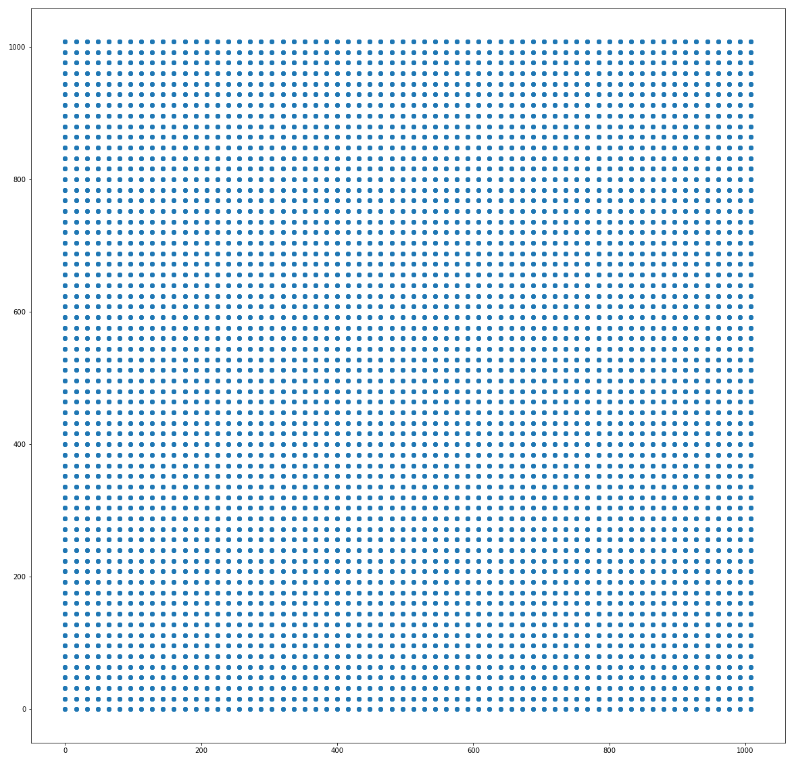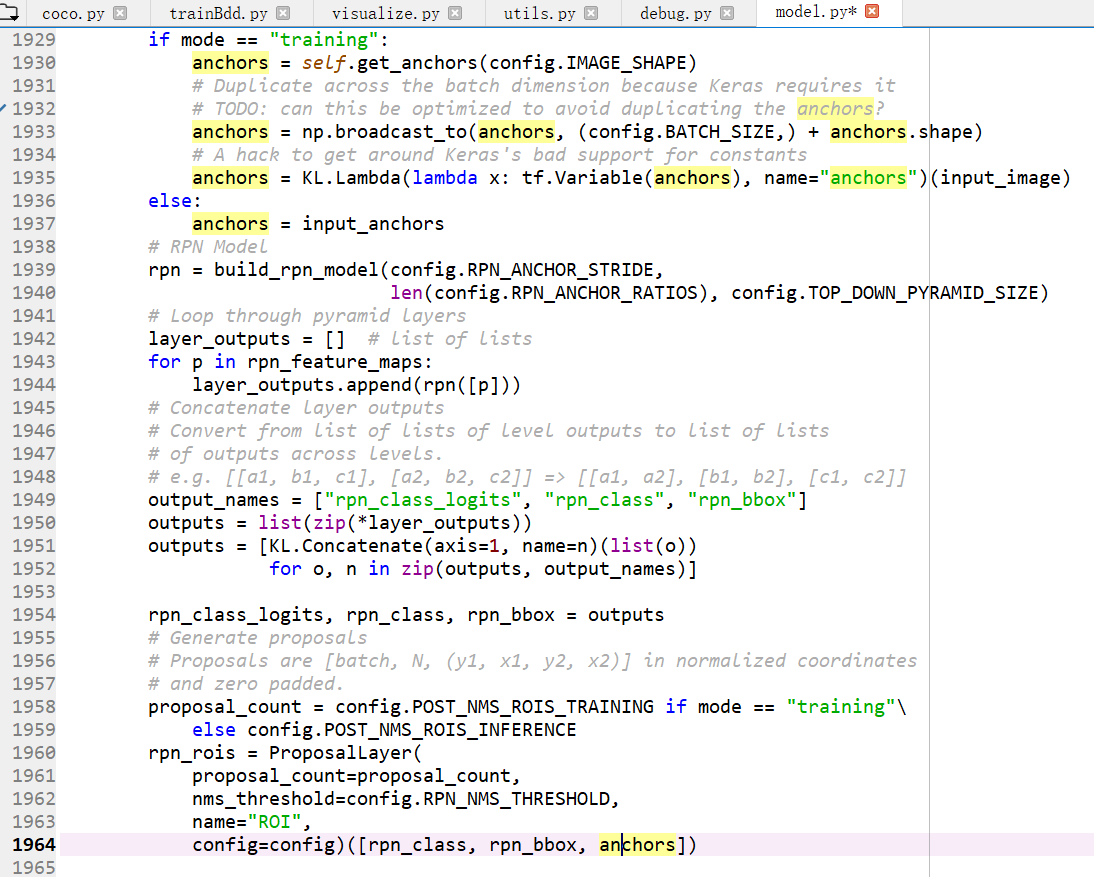Mask rcn nanchor部分理解
Anchors
Mask 生成锚框本质与SSD一样
中心点个数等于特征层像素数
框体生成围绕中心点
Bbox的坐标是要归一化到0~1之间的,都是相对于输入图片的大小。
基本生成方式:
H乘np.sqrt(anchor_ratio)
W乘np.sqrt(anchor_ratio)
这样,H:W = ratio
Mask rcnn
self.config.BACKBONE_STRIDES = [4, 8, 16, 32, 64]
# 特征层的下采样倍数,中心点计算使用
self.config.RPN_ANCHOR_RATIOS = [0.5, 1, 2] # 特征层锚框生成参数
self.config.RPN_ANCHOR_SCALES = [32, 64, 128, 256, 512] # 特征层锚框感
anchor生成:
锚框生成入口函数位于model.py中的get_anchor函数,需要参数image_shape,保证含有[h, w]即可,也可以包含[h, w, c],
def get_anchors(self, image_shape):
"""Returns anchor pyramid for the given image size."""
# [N, (height, width)]
backbone_shapes = compute_backbone_shapes(self.config, image_shape)
# Cache anchors and reuse if image shape is the same
if not hasattr(self, "_anchor_cache"):
self._anchor_cache = {}
if not tuple(image_shape) in self._anchor_cache:
# Generate Anchors: [anchor_count, (y1, x1, y2, x2)]
a = utils.generate_pyramid_anchors(
self.config.RPN_ANCHOR_SCALES, # (32, 64, 128, 256, 512)
self.config.RPN_ANCHOR_RATIOS, # [0.5, 1, 2]
backbone_shapes, # with shape [N, (height, width)]
self.config.BACKBONE_STRIDES, # [4, 8, 16, 32, 64]
self.config.RPN_ANCHOR_STRIDE) #
# Keep a copy of the latest anchors in pixel coordinates because
# it's used in inspect_model notebooks.
# TODO: Remove this after the notebook are refactored to not use it
self.anchors = a
# Normalize coordinates
self._anchor_cache[tuple(image_shape)] = utils.norm_boxes(a, image_shape[:2])
return self._anchor_cache[tuple(image_shape)]
调用函数compute_backbone_shapes计算各个特征层shape:
def compute_backbone_shapes(config, image_shape):
"""Computes the width and height of each stage of the backbone network. Returns:
[N, (height, width)]. Where N is the number of stages
"""
if callable(config.BACKBONE):
return config.COMPUTE_BACKBONE_SHAPE(image_shape) # Currently supports ResNet only
assert config.BACKBONE in ["resnet50", "resnet101"]
return np.array(
[[int(math.ceil(image_shape[0] / stride)),
int(math.ceil(image_shape[1] / stride))]
for stride in config.BACKBONE_STRIDES]) # [4, 8, 16, 32, 64]
调用函数utils.generate_pyramid_anchors生成全部锚框:
def generate_pyramid_anchors(scales, ratios, feature_shapes, feature_strides,
anchor_stride):
"""Generate anchors at different levels of a feature pyramid. Each scale
is associated with a level of the pyramid, but each ratio is used in
all levels of the pyramid. Returns:
anchors: [N, (y1, x1, y2, x2)]. All generated anchors in one array. Sorted
with the same order of the given scales. So, anchors of scale[0] come
first, then anchors of scale[1], and so on.
"""
# Anchors
# [anchor_count, (y1, x1, y2, x2)]
anchors = []
for i in range(len(scales)):
anchors.append(generate_anchors(scales[i],
ratios,
feature_shapes[i],
feature_strides[i],
anchor_stride))
# [anchor_count, (y1, x1, y2, x2)]
return np.concatenate(anchors, axis=0)
utils.generate_pyramid_anchors会调用utils.generate_anchors来生成每一层的锚框(介绍见『Numpy』np.meshgrid):
def generate_anchors(scales, ratios, shape, feature_stride, anchor_stride):
"""
scales: 1D array of anchor sizes in pixels. Example: [32, 64, 128]
ratios: 1D array of anchor ratios of width/height. Example: [0.5, 1, 2]
shape: [height, width] spatial shape of the feature map over which
to generate anchors.
feature_stride: Stride of the feature map relative to the image in pixels.
anchor_stride: Stride of anchors on the feature map. For example, if the
value is 2 then generate anchors for every other feature map pixel.
"""
# Get all combinations of scales and ratios
scales, ratios = np.meshgrid(np.array(scales), np.array(ratios))
scales = scales.flatten()
ratios = ratios.flatten() # Enumerate heights and widths from scales and ratios
heights = scales / np.sqrt(ratios)
widths = scales * np.sqrt(ratios) # Enumerate shifts in feature space
shifts_y = np.arange(0, shape[0], anchor_stride) * feature_stride
shifts_x = np.arange(0, shape[1], anchor_stride) * feature_stride
shifts_x, shifts_y = np.meshgrid(shifts_x, shifts_y) # Enumerate combinations of shifts, widths, and heights
box_widths, box_centers_x = np.meshgrid(widths, shifts_x) # (n, 3) (n, 3)
box_heights, box_centers_y = np.meshgrid(heights, shifts_y) # (n, 3) (n, 3) # Reshape to get a list of (y, x) and a list of (h, w)
# (n, 3, 2) -> (3n, 2)
box_centers = np.stack([box_centers_y, box_centers_x], axis=2).reshape([-1, 2])
#box_centers_y, box_centers_x都是坐标矩阵,要想恢复各个点的坐标,调用np.stack函数,指定axis
box_sizes = np.stack([box_heights, box_widths], axis=2).reshape([-1, 2]) # Convert to corner coordinates (y1, x1, y2, x2) boxes = np.concatenate([box_centers - 0.5 * box_sizes, box_centers + 0.5 * box_sizes], axis=1) # 框体信息是相对于原图的, [N, (y1, x1, y2, x2)] return boxes

boxes的长宽:
self.config.RPN_ANCHOR_RATIOS = [0.5, 1, 2] # 特征层锚框生成参数
self.config.RPN_ANCHOR_SCALES = [32, 64, 128, 256, 512] # 特征层锚框感
最小的框:
heights: 32/sqrt(0.5) = 45.25 width: 32 * sqrt(0.5) = 22.62
height: 32/sqrt(1) = 32 width:32* sqrt(1) = 32
最大的框:
heights: 512/sqrt(2) = 362 widths: 512*sqrt(2) = 724
最后回到get_anchor,调用utils.norm_boxes将锚框坐标化为01之间:
def norm_boxes(boxes, shape):
"""Converts boxes from pixel coordinates to normalized coordinates.
boxes: [N, (y1, x1, y2, x2)] in pixel coordinates
shape: [..., (height, width)] in pixels Note: In pixel coordinates (y2, x2) is outside the box. But in normalized
coordinates it's inside the box. Returns:
[N, (y1, x1, y2, x2)] in normalized coordinates
"""
h, w = shape
scale = np.array([h - 1, w - 1, h - 1, w - 1])
shift = np.array([0, 0, 1, 1])
return np.divide((boxes - shift), scale).astype(np.float32)

抄自:https://www.cnblogs.com/hellcat/p/9854736.html
Mask rcn nanchor部分理解的更多相关文章
- mask rcnn input数据理解
Array.min() #无参,所有中的最小值 Array.min(0) # axis=0; 每列的最小值 Array.min(1) # axis=1:每行的最小值 字符串在输出时的对齐: S.lju ...
- Mask R-CNN论文理解
摘要: Mask RCNN可以看做是一个通用实例分割架构. Mask RCNN以Faster RCNN原型,增加了一个分支用于分割任务. Mask RCNN比Faster RCNN速度慢一些,达到了5 ...
- 深入理解 Android 之 View 的绘制流程
概述 本篇文章会从源码(基于Android 6.0)角度分析Android中View的绘制流程,侧重于对整体流程的分析,对一些难以理解的点加以重点阐述,目的是把View绘制的整个流程把握好,而对于特定 ...
- [译] 理解数组在 PHP 内部的实现(给PHP开发者的PHP源码-第四部分)
文章来自:http://www.hoohack.me/2016/02/15/understanding-phps-internal-array-implementation-ch 原文:https:/ ...
- 【blade的UI设计】理解前端MVC与分层思想
前言 最近校招要来了,很多大三的同学一定按捺不住心中的焦躁,其中有期待也有彷徨,或许更多的是些许担忧,最近在开始疯狂的复习了吧 这里小钗有几点建议给各位: ① 不要看得太重,关心则乱,太紧张反而表现不 ...
- 利用layer的mask属性实现逐渐揭示的动画效果
github上又看到个不错的动画(https://github.com/rounak/RJImageLoader),如图: 所以就想来自己实现以下 不试不知道,这个动画还真不是看上去那么简单,我自己想 ...
- 理解 OpenStack 高可用(HA)(3):Neutron 分布式虚拟路由(Neutron Distributed Virtual Routing)
本系列会分析OpenStack 的高可用性(HA)概念和解决方案: (1)OpenStack 高可用方案概述 (2)Neutron L3 Agent HA - VRRP (虚拟路由冗余协议) (3)N ...
- Deep learning:四十六(DropConnect简单理解)
和maxout(maxout简单理解)一样,DropConnect也是在ICML2013上发表的,同样也是为了提高Deep Network的泛化能力的,两者都号称是对Dropout(Dropout简单 ...
- Deep learning:四十一(Dropout简单理解)
前言 训练神经网络模型时,如果训练样本较少,为了防止模型过拟合,Dropout可以作为一种trikc供选择.Dropout是hintion最近2年提出的,源于其文章Improving neural n ...
随机推荐
- jsp 自定义标签解决jsp页面中int时间戳的时间格式化问题
jsp 自定义标签解决jsp页面中int时间戳的时间格式化问题 之前在项目中根据需求,需要自定义标签,经过查询w3c文档,自己也踩了一些坑,特此记录自定义标签的步骤,下面就以我之前的一个例子中的定义一 ...
- php删除文件夹
function deldir($dir) { $dh=opendir($dir); while ($file=readdir($dh)) { if($file!="." & ...
- C#的托管与非托管大难点
托管代码与非托管代码 众所周知,我们正常编程所用的高级语言,是无法被计算机识别的.需要先将高级语言翻译为机器语言,才能被机器理解和运行.在标准C/C++中,编译过程是这样的:源代码首先经过预处理器,对 ...
- mysql 编码问题
有时候insert数据的时候,会报以下异常: ERROR 1366 (HY000): Incorrect string value: '\xE6\x9D\x83\xE9\x99\x90...' for ...
- 将win7 设置为 NTP服务器
1. 修改注册表项 HKEY_LOCAL_MACHINE\SYSTEM\CurrentControlSet\Services\W32Time\TimeProviders\NtpServer Enabl ...
- 阿里云入坑指南&&nodejs 安装配置
买了阿里云1G1核1M的机器(800元,3年) 登录阿里云-实例-选择实例所在地区-重置密码 用公网IP ssh连接 #升级CentOS yum -y update #安装or更新组件 yum -y ...
- 爬虫-----selenium模块自动爬取网页资源
selenium介绍与使用 1 selenium介绍 什么是selenium?selenium是Python的一个第三方库,对外提供的接口可以操作浏览器,然后让浏览器完成自动化的操作. sel ...
- linux 逆向映射
逆向映射用于建立物理内存页和使用该页的进程的对应页表项之间的联系,在换出页时以便更新所有涉及的进程.得到物理页基址后,根据pfn_to_page可以将页框转换为page实例,page实例中的mappi ...
- Hello Json(c#)
第一步:下载的DLL→Newtonsoft.Json 打开链接后下载这个(有可能版本有所更新,选前面点的就是了): 接下来是新建一个Console项目,然后是引用,然后上码 class Progra ...
- 导出CityGML
通过代码实现了导出CityGML功能
